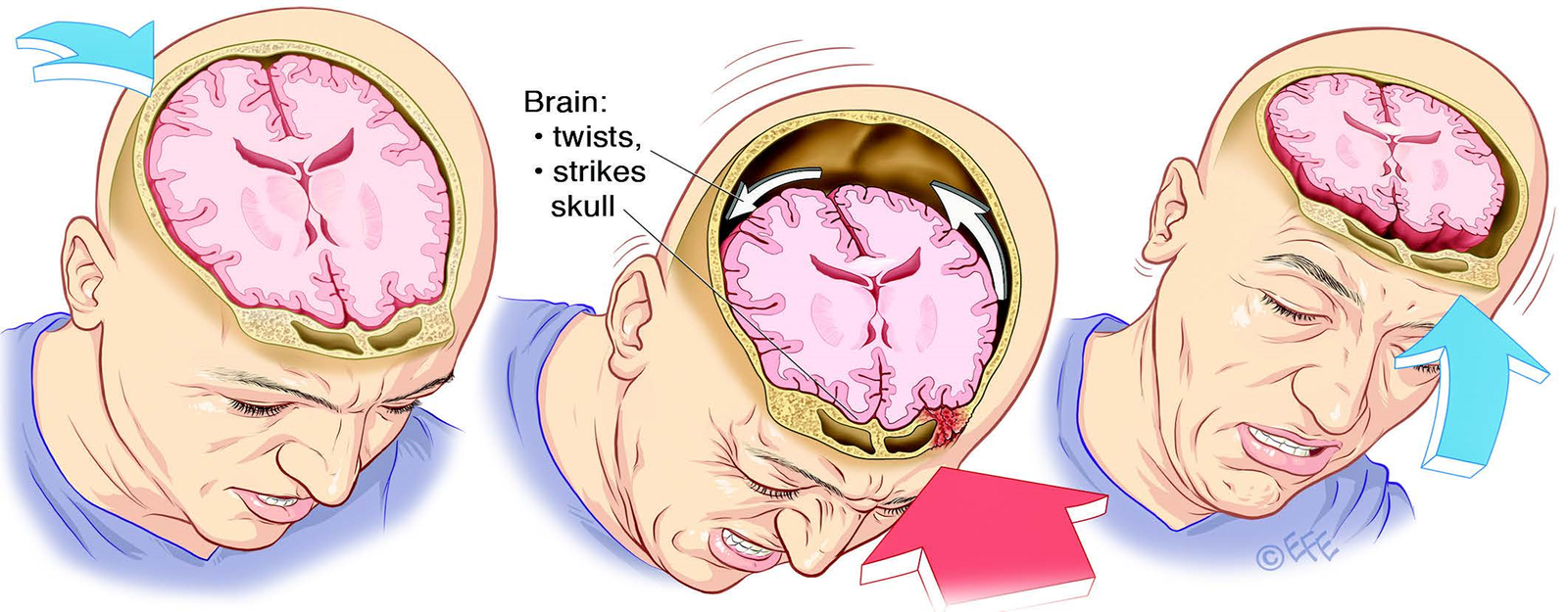Concussion is often described as a clinical syndrome characterized by immediate and transient posttraumatic impairment of neural function, such as alteration of consciousness or disturbance of vision or equilibrium, and other signs and symptoms due to brain stem involvement. Concussions are usually caused by a blow to the head or violently shaking head and upper body. For more than 1000 years, concussion has been recognized as a clinical entity. A cerebral concussion is both the most common and most puzzling type of traumatic brain injury (TBI). Concussion is also caused by violent jarring or shaking that results in a disturbance of brain functions. It affects brain function. The amount of brain injury depends upon severity. Concussion has also been defined as a “trauma-induced alteration in mental status that may or may not involve a loss of consciousness.
A series of neurochemical changes develops when head trauma induces an alteration in neurologic function. There takes place a sudden release of excitatory neurotransmitters, mainly binding of glutamate to N-methyl-d-aspartate receptors, causing a sudden release of potassium into the extracellular space, followed by the influx of calcium into the cell. As a result, a transient hypermetabolic glycolytic state develops as membrane pumps become active to restore homeostasis. Lactate produced impairs neuronal function, followed by reduction of blood flow and diminished glucose utilization. It is found that even axonal injury occurs if calcium persists in mitochondria. The standard recovery time is 7-10 days, the diminished blood flow and the altered metabolic state may last for weeks, and the neural tissue is more susceptible to further injury during this period. The pathophysiologic process results in cortical spreading depression following head trauma which is also observed in migraine and maybe the cause of dysfunction occurring in transient global amnesia. The brain injury falls under 3 categories:
• Direct impact brain injury
• Acceleration-deceleration brain injury
• Blast brain injury
The exact mechanisms of concussion are unknown. Axon tearing is found to occur in more severe brain injuries, but there is a lack of proof of concussion. Several studies found that concussion is due to rotational acceleration of the brain, i.e., jiggling of the brain that produces a disordered biochemical injury or metabolic cascade such as altered metabolism of glucose or derangement of adenine nucleotides. Symptoms Related to Concussion are:
• Headache/feeling of pressure in the head
• Dizziness
• Slurred speech while speaking
• Temporary loss of consciousness
• Feeling of ringing in the ears
• Delayed response to questions
• Confusion
• Nausea
• Amnesia surrounding the traumatic event
• Vomiting
• Fatigue

When a patient suffers any kind of head injury, the initial concern arises as to whether the traumatic stress has caused any subdural or hematoma, parenchymal hemorrhage, or increased intracranial pressure. Concussion is normally produced by acceleration/deceleration of head and is often characterized by a sudden brief impairment of consciousness, memory loss, and paralysis of reflex activity. Effects are usually temporary but include headache and further complications in concentration, memory, balance, and coordination. Neurofeedback comes as the choice for the treatment of concussion.
The importance of exact management and timely recognition arises from the consequence of misdiagnosis or faulty management that may lead to major disability or even death in both long-term and short-term concussions. The treatment generally involves:
• normalizing post-concussion symptoms and emphasizing their non-malignant nature;
• providing an optimistic prognosis and estimation of the probable recovery time;
• explaining the nature and the way to cope with the impairments of the speed of information processing;
• explaining the way symptoms can be used as a ‘temperature gauge’ indicating when to increase or decrease demands and take breaks;
Concussion is most often identified with sports such as football, boxing, ice hockey, and martial arts; recent research data has also shown that concussion also occurs in many different sports. International Consensus Conference defines concussion in Sports as “a complex pathophysiological process” affecting the brain, induced by biomechanical forces. Continued improvement in prevention and management strategies for concussion requires a strong body of research from a variety of different disciplines. The researchers are trying to provide better recommendations for the management and prevention of the concussion; till then the treatment of the injured player falls completely on the clinicians.

